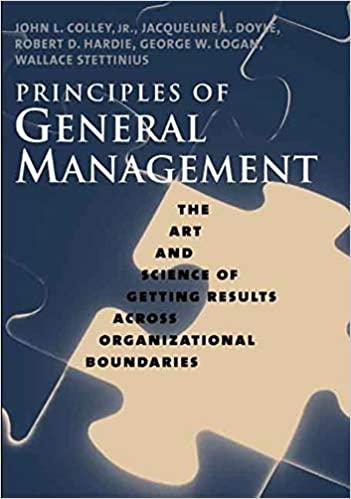Question
Please read the following resources. Human Resource Management, Sean Valentine, Patricia Meglich, Robert L. Mathis, John H. Jackson, Cengage, 2020 Chapter 11, Sections: 11-4 through
Please read the following resources.
- Human Resource Management, Sean Valentine, Patricia Meglich, Robert L. Mathis, John H. Jackson, Cengage, 2020
Chapter 11, Sections: 11-4 through 11-7
- Allocating Merit Increases, Nkomo
- SHRM Research Shows Pay Equity Pays Off for Employers, SHRM, 2021 First, refer to "Allocating Merit Raises" in the Nkomo text. Generate a detailed response to the questions asked at the beginning of this exercise.
Assignment Documents -
https://cyberactive.bellevue.edu/webapps/blackboard/content/listContent.jsp?course_id=_527119_1&content_id=_15603479_1&mode=reset#:~:text=Nkomo%20Case%20Study%2C%20Merit%20Increases
INCIDENT: MERIT INCREASES
The task for this assignment is to develop a fair procedure that will be used to determine merit raises and then decide the dollar raise to be given to each professor. Be sure to provide not only the dollar amount of the raises, but also fully explain your process for determining raises and the rationale behind them.
Situation
Small State University is located in the eastern part of the United States and has an enrollment of about 8,000 students. The College of Business has 40 full-time and more than 30 part-time faculty members. The college is divided into five departments: Management, Marketing, Finance and Accounting, Decision Sciences, and Information Technology. Faculty members in the Management Department are evaluated each year based on three primary criteria: 1) teaching, 2) research, and 3) service. Teaching performance is based on student course evaluations over a two-year period. Service to the university, college, profession, and community is also based on accomplishments over a two-year period. Research is based on the number of journal articles published over a three-year period. Teaching and research are considered more important than service to the university. In judging faculty performance, the department chair evaluates each professor in terms of four standards: Far Exceeds Standards, Exceeds Standards, Meets Standards, and Fails to Meet Standards. The results of this year's evaluations are shown in Exhibit 4.3.
Exhibit 4.3. Department Chairs' Rating of Job Performance
Professor Current Salary Teaching Research Service
Houseman $92,000 Exceeds Exceeds Meets
Jones $116,000 Exceeds Far Exceeds Exceeds
Ricks $135,000 Meets Meets Far Exceeds
Matthews $97,000 New Hire New Hire New Hire
Karas $100,000 Far Exceeds Exceeds Meets
Franks $90,000 Meets Fails to Meet Exceeds
Due to financial problems and cutbacks this year, Small State University has agreed to give raises totaling just $6,300 to the Management Department. Your task as department chair is to divide the $6,300 among the faculty members. Keep in mind that these raises will likely set a precedent for the future and that the professors will view the raises as a signal for what behavior and achievements are valued.
A profile of each of the professors is provided below.
Professor Houseman: 55 years old; 25 years with the university; teaches Principles of Management sections; teaches over 400 students per year; has written over 40 articles and given over 30 presentations since joining the college; wants a good raise to catch up with others.
Professor Jones: 49 years old; 10 years with the university; teaches Human Resource Management and Organizational Behavior; stepped down as department chair three years ago; teaches about 200 students a year; has written over 30 articles and two books since joining the college; recently received an $80,000 grant for the college from a local foundation, and wants a good raise as a reward for obtaining the grant.
Professor Ricks: 61 years old; 6 years with university; teaches Labor Relations and Organizational Development; stepped down as dean of the College of Business two years ago and took a $20,000 pay cut; teaches about 180 students per year; has written only two articles in the last six years due to administrative duties; very active in the community and serves on several charity boards; wants a good raise to make up for loss of $20,000. Professor Matthews: 28 years old; new hireonly four months with the university; teaches Employee Relations and Compensation Management; just graduated with a PhD; will teach about 110 students this year. To be competitive in the job market, the college paid Professor Matthews $97,000 plus provided a reduced teaching load for two years and a $6,000 per year summer stipend; none of the other faculty received this when they were first hired or subsequently; had two minor publications while a doctoral student but none since joining the college; wants a good raise to pay student loans and furnish a new residence.
Professor Karas: 32 years old; 4 years with university; teaches International Business and Honors sections of Management Principles; teaches about 150 students per year; won Teacher of the Year Award this year; published 12 articles in last four years; has been interviewing for a new job at other universities and may leave if a good raise is not forthcoming.
Professor Franks: 64 years old; 18 years with university; teaches Principles of Management and Human Resource Management; teaches about 150 students per year; principal advisor for management-major students; has not written any articles during the last four years; plans on retiring within two-three years, and wants a good raise to enhance pension plan.
All resources should be included and cited according to APA format.
Step by Step Solution
There are 3 Steps involved in it
Step: 1

Get Instant Access to Expert-Tailored Solutions
See step-by-step solutions with expert insights and AI powered tools for academic success
Step: 2

Step: 3

Ace Your Homework with AI
Get the answers you need in no time with our AI-driven, step-by-step assistance
Get Started


